Chapter 11 Human Eye and Colourful World Class 10 Science Important Questions and Answers PDF will help you in scoring more marks. This consists of 1 mark Questions, 3 Mark Numericals Questions, 5 Marks Numerical Questions and previous year questions from Chemical Reactions and Equations Chapter.
Human Eye and Colourful World Class 10 Important Questions and Answers Science Chapter 11
Very Short Answer Questions ( 1 Mark)
Based on Human Eye
Question 1.
Name the following part of human eye : A thin membrane through which light enters the eye. (CBSE 2011)
Answer:
Cornea.
More Resources
- Previous Year Question Papers for CBSE Class 10 Science
- NCERT Solutions for Class 10 Science
- NCERT Exemplar Solutions for Class 10 Science
- Value Based Questions in Science for Class 10
- HOTS Questions for Class 10 Science
Question 2.
Write the function of iris in the human eye. [CBSE 2007 (Delhi), 2015, 2016]
Or
Mention the name of a structure formed in human eye that controls the size of the pupil. (CBSE 2012)
Answer:
Iris controls the size of the pupil.
Question 3.
What is the function of pupil in human eye ? (CBSE 2011, 2012)
Answer:
It controls and regulates the light entering the eye.
Question 4.
Name the following part of human eye : A dark muscular diaghram that controls the size of the pupil.
(CBSE 2011)
Answer:
Iris.
Question 5.
Name the type of lens in human eye.
Answer:
Convex lens.
Question 6.
Name the part of human eye that helps in changing the focal length of the eye lens.
Or
Name the part responsible for the power of accommodation of the human eye.
Answer:
Ciliary Muscles.
Question 7.
Name the ability of eye lens to adjust its focal length.
Answer:
Accommodation.
Question 8.
What is the nature of the image formed at the retina of human eye ?
Answer:
Real and inverted image.
Question 9.
Name the part of human eye which acts as a screen to obtain the image of an object. (CBSE 2012, 2014)
Answer:
Retina.
Question 10.
Mention the value of near point for normal eye. (CBSE 2014, 2015)
Answer:
25 cm.
Question 11.
Mention the value of far point for normal eye. (CBSE 2014, 2015)
Answer:
Infinity.
Question 12.
Mention the value of range of vision for normal eye. (CBSE 2014, 2016)
Answer:
Range of vision for normal eye is 25 cm to infinity.
Question 13.
Copy the following diagram on your answer sheet after showing the refracted rays of light from eye lens, assuming the eye is a normal human eye.
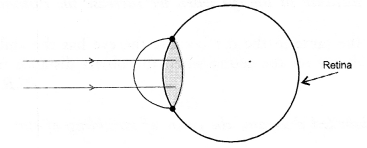
Answer:

Question 14.
Name two common defects of vision. (CBSE 2015, 2016)
Answer:
- Myopia
- Hypermetropia.
Question 15.
What is hypermetropia or far-sightedness ? [CBSE (Foreign) 2008]
Answer:
A human eye which can see distant objects clearly but cannot see the near objects clearly is said to be suffered with a defect called hypermetropia or far sightedness.
Question 16.
Name the type of a lens used to correct hypermetropic eye.
Answer:
Convex lens.
Question 17.
What is Myopia or near-sightedness ? (CBSE 2011)
Answer:
A human eye which can see near objects clearly but cannot see the distant objects clearly is said to be suffered with a defect called myopia or near-sightedness.
Question 18.
Name the type of a lens used to correct myopic eye.
Answer:
Concave lens.
Question 19.
Name the vision defect due to which a person can neither clearly see objects placed at the near point nor at infinity.
Answer:
Presbyopia.
Question 20.
State the type of corrective lens which is required by a person who can neither clearly see objects placed at the near point nor at infinity. (CBSE 2014)
Answer:
Bi- focal lens.
Question 21.
Make a ray diagram to show how the eye defect myopia is corrected by using a suitable lens ? (CBSE 2008, 2011)
Answer:
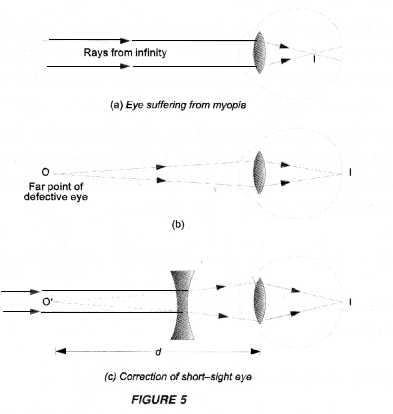
Question 22.
Make a ray diagram to show how the eye defect hypermetropic or far sightedness is corrected by using a suitable lens. (CBSE 2008, 2011)
Answer:
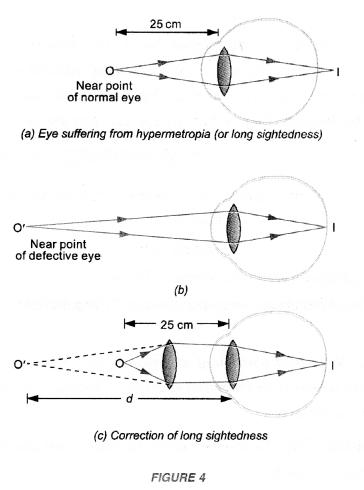
Question 23.
Draw a diagram to show the formation of image of a distant object by a myopic eye. How can such an eye defect be remedied ? (CBSE (Delhi) 2008)
Answer:
For ray diagram, see figure 5 (a).

Myopia can be remedied by using a concave lens of suitable focal length.
Question 24.
State two reasons due to which myopia may be caused.
Answer:
This defect arises due to either by
- the elongation of the eye ball or
- the excessive curvature of the cornea.
Question 25.
d short sighted person cannot see clearly beyond 2 m. Calculate the power of less required to correct his vision. (CBSE 2011)
Answer:
Here, d = 2 m
The concave lens of focal length f= – d is needed to correct his vision .’. f = – d = – 2 m
![]()
Question 26.
Copy the following diagram on your answer sheet showing the formation of image, assuming the given eye is a myopic eye. (CBSE 2011)
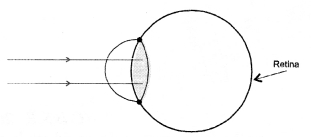
Answer:

Question 27.
Copy of following diagram on your answer sheet showing the formation of image, assuming that the given eye is hypermetropic eye.
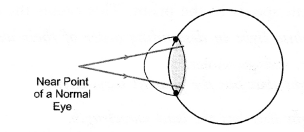
Or
Draw ray diagram showing hypermetropic eye.
Answer:
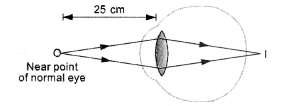
Question 28.
A person is advised to wear spectacles with concave lenses. What type of defect of vision is he suffering from ?
(CBSE 2012)
Answer:
Myopia.
Question 29.
A person is advised to wear spectacles with convex lenses. What type of defect of vision is he suffering from ?
Answer:
Hypermetropia.
Question 30.
Draw a diagram showing refraction of a ray of light through a glass prism and mark the angle of deviation.
(CBSE 2011)
Or
Draw a ray diagram to explain the term angle of deviation. (CBSE 2017)
Answer:

The angle between the directions of incident ray and emergent ray from the prism is called angle of deviation.
Question 31.
Copy the following diagram on your answer sheet showing the different colours on the white screen.

Answer:
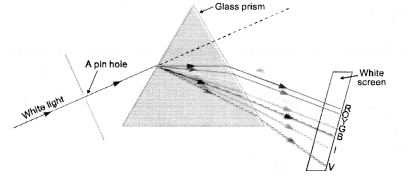
Based on Dispersion of light
Question 32.
What is dispersion of light ? (CBSE 2012, 2015, CBSE (Foreign) 2016)
Answer:
The phenomenon of splitting white light into seven colours when it passes through a glass prism is called dispersion of light.
Question 33.
What is the came of dispersion of light ?
Or
State the came of dispersion of white light by a glass prism. (CBSE 2017)
Answer:
When white light passes through a glass prism, its constituent colours (red, orange, yellow, green, blue, indigo, violet) travel with different speeds in the prism. This causes the dispersion of light.
Question 34.
Arrange constituent colours of white light in descending order of their wavelengths.
Answer:
Red, orange, yellow, green, blue, indigo, violet. .
Question 35.
Name the component of white light that has the greatest wavelength. (CBSE Sample Paper 2016)
Answer:
Red colour.
Question 36.
Name the component of white light that has the least wavelength.
Answer:
Voilet colour.
Question 37.
Name the component of white light that deviates (i) the least and (ii) the most while passing through a glass 4 prism. (CBSE 2011, 2012, 2014, 2015, 2016)
Answer:
- red colour,
- violet colour.
Question 38.
Name the phenomenon occurring in nature due to dispersion of light.
Answer:
Rainbow.
Question 39.
Name the three phenomenon of light responsible for the formation of rainbow in the sky.
Answer:
- Refraction,
- dispersion and
- internal reflection of light.
Question 40.
Name the colours that suffer maximum and minimum deviation respectively while passing through a prism.
(CBSE 2014)
Answer:
Red colour suffers minimum deviation and violet colour suffers maximum deviation.
Question 410.
Light of two colours A and B pass through a glass prism. A deviates more than B from its path of incidence.
Which colour has a higher speed in the prism ? (CBSE 2011)
Answer:
Colour B has higher speed than that of colour A.
Question 42.
What is meant by scattering of light ? (CBSE 2014, 2015, 2016)
Answer:
When sunlight enters the atmosphere of the earth, the atoms and molecules of different gases present in the atmosphere absorb this light. Then these atoms and molecules of the gases re-emit light in all directions. This process is known as scattering of light. The atoms or particles scattering light are known as scatterers.
The intensity of scattered light is inversely proportional to the fourth power of the wavelength of incident light, if the size of the particles (say atoms or molecules) scattering the light is less than the wavelength of the incident light.
Short Answer Questions (2 & 3 Marks)
Based on Human Eye
Question 1.
When we enter a dim-lit room from a bright light, we are not able to see the object in the room for some time.
Explain, why ? (CBSE 2011, 2016)
Or
Why does it take some time to see objects in a cinema hall when we just enter the hall from bright sun light ? Explain. (CBSE 2011)
Answer:
In a bright light, the iris contracts the pupil of an eye to allow less light to enter the eye. When, we enter the dim-lit room, iris takes time to expand the pupil of an eye to allow more light to enter the eye so that the visible image of the object lying in the room are formed on the retina of the eye.
Question 2.
The ciliary muscles of a normal eye are in their (i) most relaxed (ii) most contracted state. In which of the two cases is the focal length of the eye-lens more ? (CBSE Sample Paper)
Answer:
The focal length of eye-lens is more when the ciliary muscles of a normal eye are in their most relaxed state.
Question 3.
Why do we have two eyes instead of one eye ?
Answer:
Two eyes are better than one eye because
- the field of view with two eyes is more than with one eye.
- two eyes give three dimensional picture of an object (i.e., the length, breadth and depth or height of an object) whereas one eye gives only two dimensional picture of an object.
Question 4.
A convex lens made of glass forms a sharp image on the screen for a particular position of an object with respect to the lens. A human eye lens is also a convex lens but it can form sharp images on the retina of eye for different positions of the objects. Explain, why ? (CBSE 2010)
Answer:
A convex lens made of glass has a fixed focal length and hence it forms a sharp image on the screen for a particular position of an object. However, the focal length of human eye lens can be changed by the action of ciliary muscles. In other words, human eye lens has the ability to chartge its focal length to form sharp images of objects at different positions. The process is known as accommodation of eye.
Question 5.
How is a normal eye able to see distinctly distant as well as nearer objects ? What is the distance of distinct vision ? (CBSE 2012)
Answer:
Eye has the ability known as accommodation of eye to see distant as well as nearer objects clearly. When objects is far away, the focal length of lens is increased due to the relaxed ciliary muscles. Hence sharp image of object is formed on the retina of eye. When object is nearer to the eye, the focal length of lens is decreased due to the contraction of ciliary muscles and hence sharp image of the object is formed on the retina of eye. The distance of distinct vision is 25 cm.
Based on Defects of Vision
Question 6.
What is short-sightedness ? How can this defect be corrected ? (Bihar Board 2012)
Answer:
Short-sightedness or near-sightedness or Myopia
A human eye is myopic if it can see the near objects clearly but unable to see far off objects or distant objects clearly.
Causes of Wlyopia: This defect arises due to either by
- the elongation of the eye ball or
- the excessive curvature of the cornea.
Question 7.
What is long-sightedness ? How can this defect be corrected ?
Answer:
A human eye which can see far off objects or distant objects clearly but can not see the near objects clearly is said to be suffered with a defect known as long sightedness or far sightedness or Hypermetropia.
Causes of Hypermetropia: This defect arises due to either by
- the increase in the focal length of eye lens or
- the size of the eye ball becomes too small so that the light rays from the nearby points or objects are not brought to focus on the retina of the eye.
Question 8.
What is presbyopia ? State the cause of Presbyopia. How is presbyopia of a person be corrected ?
[CBSE (All India) 2009]
Answer:
A human eye which cannot see the near objects and distant objects clearly is said to suffer from a defect known as Presbyopia. Eye suffering from Presbyopia cannot read and write comfortably.
This defect arises due to the ageing of a person. The ciliary muscles are weakened and the flexibility of the crystalline lens of the human eye decreases with age of the person. As a result, human eye is unable to focus on close as well as distant objects.
This defect can be corrected by using a bi-focal lens. A bi-focal lens consists of a concave lens which forms the upper surface of the bi-focal lens and a convex lens which forms the lower surface of the bi-focal lens. The upper surface of bi-focal lens (i.e. the concave lens) enables the person to see distant objects clearly and the lower surface of bi-focal lens {i.e. convex lens) enables the person to see the near objects.
Question 9.
An old person is unable to see clearly nearby object as well as distant objects.
- What defect of vision is he suffering from ?
- What kind of lens will be required to see clearly the nearby as well as distant objects ? Give reasons ?
(CBSE 2012, 2014)
Answer:
- Presbyopia.
- This defect is connected by using bi-focal lens. A bi-focal lens consists of a concave lens which forms the upper surface of lens and a convex lens which form the lower surface of the lens. The upper surface enables the person to see distant objects clearly and the lower surface helps the person to see the near objects clearly.
Question 10.
A person suffering from an eye-defect uses lens of power -1D. Name the defect he is suffering from and the nature of lens used. (CBSE 2015)
Answer:
He is suffering from myopia. The lens is concave lens.
Question 11.
A person suffering from an eye-defect uses lens of power + IS D. Name the defect he is suffering from and the nature of lens used.
Answer:
He is suffering from hypermetropia. The lens is convex lens.
Question 12.
Explain why the image distance in the eye does not change when we change the distance of an object from the eye ? (CBSE 2017)
Answer:
This is because the eye lens has the ability to change its focal length to make the image always on the retina when the distance of the object from the eye is changed.
Question 13.
Due to gradual weakening of ciliary muscles and diminishing flexibility of the eye lens a certain defect of
vision arises. Write the name of this defect. Name the type of lens required by such persons to improve the vision. Explain the structure and function of such a lens. (CBSE 2017)
Answer:
Name of defet : Presbyopia
Type of lens required by persons suffering presbyopia to improve the vision is bi-focal lens.
Bi-focal lens consists of a concave lens which forms the upper surface of a bi-focal lens and a convex lens which forms the lower surface of the bi-focal lens. The upper surface of the lens enables the person to see distant objects clearly and the lower surface of the lens enables the person to see the near objects clearly.
Based on Dispersion of Light
Question 14.
What is dispersion of light ? What is the cause of dispersion ? Draw a diagram to show the dispersion of white light by a glass prism. [CBSE (All India) 2009, 2011, 2012, 2014, 2017]
Answer:
Dispersion of Light: The phenomenon of splitting white light into seven colours when it passes through a glass prism is called dispersion of light.
Cause of Dispersion: When white light passes through a glass prism, its constituent colours (red, orange, yellow, green, blue, indigo, violet) travel with different speeds in the prism. This causes the dispersion of light.
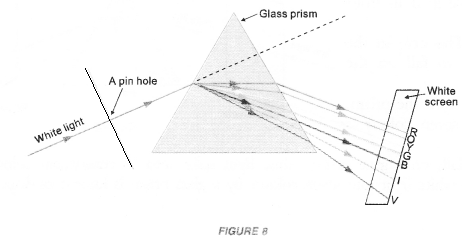
Question 15.
When white light passes through a glass prism, seven colours namely red, orange, yellow, green, blue, indigo and violet are seen on the white screen. All these colours have different angles of deviation. Explain why ?
Answer:
Speed of colour in a medium depends upon its wavelength. All the colours have different wavelength. The red colour has the longest wavelength and violet colour has the last wavelength. Therefore, red colour has the highest speed in the glass prism and the violet colour has the lowest speed in the glass prism. Hence, all colours of white light are refracted by different amounts while passing through the glass prism. Therefore, all the colours have different angles of deviations.
Question 16.
Why do different colours get separated when white light passes through prism I How can we recombine the components of white light after a prism has separated them ? Explain with the help of figure. (CBSE 2012)
Answer:
Different colours have different speeds in glass prism. Due to this fact, different colours get separated while passing through the prism.
Perform an activity to show that the colours of white light splitted by a glass prism can be recombined to get white light by another glass prism.
Apparatus required: Two glass prisms made of same kind of glass, a card board having a fine hole at its centre, a white screen.
Procedure:
- Place a card board in front of a prism A. A ray of white light coming from the hole in the card board falls on the prism A (Figure 11).

- White light splits into seven colours by prism A is made to fall on another glass prism B placed with its base upward. Since prism A disperses white light, so it is known as dispersing prism.
- The prism B deviates colours of light towards its base. The various colours recombines at the opposite lace of glass prism B.
- This activity was initially performed by the great scientist Issac Newton.
The light received on the white screen placed in front of prism B is white. Since the prism B recombines the colours of light to produce white light, so glass prism B is known as recombination prism.
Question 17.
How will you use two identical glass prisms so that a narrow beam of white light incident on one prism emerges out of the second prism as a beam of white light ? Draw a labelled diagram to illustrate it. (CBSE 2015)
Answer:
Perform an activity to show that the colours of white light splitted by a glass prism can be recombined to get white light by another glass prism.
Apparatus required: Two glass prisms made of same kind of glass, a card board having a fine hole at its centre, a white screen.
Procedure:
- Place a card board in front of a prism A. A ray of white light coming from the hole in the card board falls on the prism A (Figure 11).
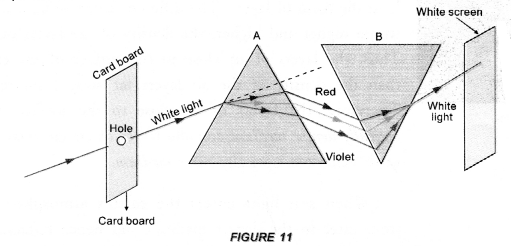
- White light splits into seven colours by prism A is made to fall on another glass prism B placed with its base upward. Since prism A disperses white light, so it is known as dispersing prism.
- The prism B deviates colours of light towards its base. The various colours recombines at the opposite lace of glass prism B.
- This activity was initially performed by the great scientist Issac Newton.
The light received on the white screen placed in front of prism B is white. Since the prism B recombines the colours of light to produce white light, so glass prism B is known as recombination prism.
Question 18.
How did Newton, using two identical glass prisms, show that white light is made of seven colours ? (CBSE 2017)
Answer:
Investigate dispersion of white light in a glass prism
- Place a thick card board having a small hole in it in front of a glass prism.
- Allow sunlight to fall on the card board. The hole in the card board allows a beam of white light to fall on the prism.
- Place a white screen at some distance away from the prism.
- Rotate the prism slowly until a band of seven colour is figure 9 observed on the white screen.
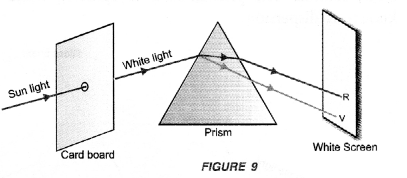
Conclusion : “When a beam of white light falls on a glass prism, white light splits into its constituent colours (i.e., seven colours). This phenomenon of splitting white light into seven colours by a glass prism is known as dispersion of white light.
Question 19.
Draiv a ray diagram to show the path of a narrow beam of white light, through a combination of two identical prisms arranged together in inverted position with respect to each other, when it is allowed to fall obliquely on one of the faces of the first prism of the combination. (CBSE 2017)
Answer:
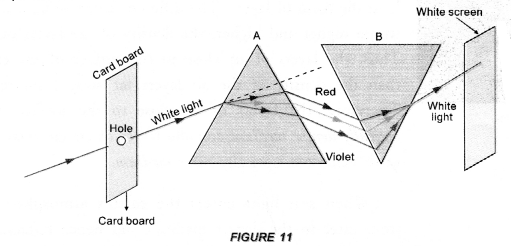
Question 20.
Why do we observe the seven colours when white light passes through a glass prism ? Which component of white light deviates the least ? (CBSE 2011, 2012)
Answer:
White light is a mixture of seven colours. The speed of different colours of white light is different in glass. So when white light passes through a glass prism, it splits into seven colours. Red colour deviates the least.
Question 21.
(i) Show formation of rainbow with the help of a ray diagram. (CBSE 2014, 2015)
(ii) What are the conditions to observe rainbow ? (CBSE 2011, 2013, 2015)
Answer:
(i)
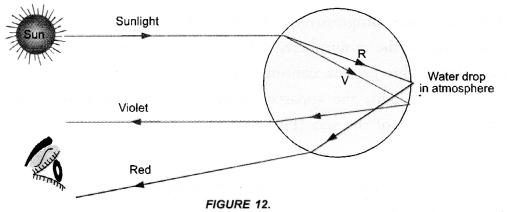
(ii) Rainbow is observed during or after rainfall provided the sun is at the back of the observer.
Question 22.
On a sunny day, stand at a certain distance from a fountain of a water such that the position of the sun is at your back. What do you observe ? Explain the reason of your observation.
Answer:
We observe a rainbow. The droplets of water behave as glass prisms. When sun light falls on these drops, dispersion of light takes place. Hence, rainbow is seen.
Question 23.
Why do we see a rainbow in the sky only after rainfall ? [NCERT Question Bank]
Answer:
You must have seen a beautiful rainbow in the sky after rainfall. This rainbow is formed due to the dispersion of sunlight.
When sunlight falls on the water drops suspended in the atmosphere after rainfall, rainbow is formed due to the dispersion of sun light. The water drops suspended in air (or atmosphere) act as prisms.
Rainbow is the example of dispersion of sunlight. The formation of rainbow after rainfall is shown in figure 12.
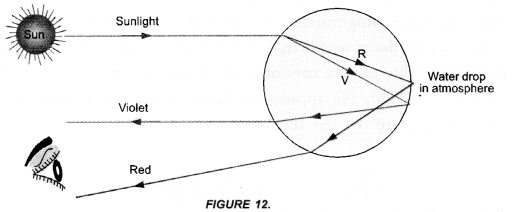
Rainbow is observed during a rainfall or after the rainfall or when we look at a water fountain provided the sun is at the back of the observer.
Conditions for Observing a Rainbow
When sunlight falls on a water drop suspended in air, then the sunlight is refracted. The refracted sunlight splits (or dispersed) into its constituent colours (i.e., seven colours). Thus, water drop suspended in air behaves as a glass prism. The red colour deviates the least and the violet colour deviates the most. Different colours of refracted sunlight fall on the opposite face of the water drop.- Now, each colour suffers internal reflection. The reflected colours on reaching the lower surface of water drop are refracted again into the air. Thus, we get a spectrum of seven colours, which is known as a rainbow.
Based on Atmospheric Refraction of light
Question 24.
Describe atmospheric refraction. Explain with the help of diagram why the sun is visible to us two minutes before the actual sun-rise and two minutes even after the sunset. (CBSE 2015, CBSE (Foreign) 2017)
Answer:
The refraction of light takes place, when light travels from one medium to another medium. In other words, refraction of light takes place, when light goes from an optically rarer medium to an optical denser medium or vice-versa. The earth’s atmosphere has air all around. The air in the atmosphere is in the form of layers. The different layers of air have different densities. As we go higher and higher, the density of the layers of air goes on decreasing. Thus, the layers of air close to the surface of the earth have more density than the density of the air layers far away from the surface of the earth. Therefore, the layers of air close to the surface of the earth behave as optically denser medium and the layers of air far away from the surface of the earth behave as optically rarer medium.
When sun light enters the earth’s atmosphere, it continuously goes from rarer to the denser medium and hence refraction of light takes place. The refraction of light taking place in the atmosphere is known as atmospheric refraction.
Question 25.
We can see the sun for few minutes even after it has actually set. Explain, why ?
Or
Explain with the help of diagram why the sun is visible to us two minutes before the actual sun-rise and two minutes after the sunset. (CBSE 2012, 2014)
Answer:
We can see the sun for few minutes even after it has actually set
Actual sun sets when it is below the horizon in the evening. The rays of light from the sun below the horizon reach our eyes because of refraction of light through atmosphere. These rays appear to come from the apparent position of the sun which is above the horizon as shown in figure 14.
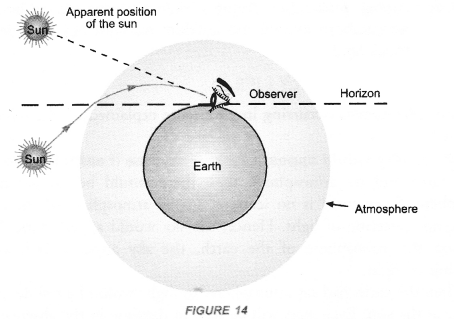
Hence we can see the sun for few minutes (about 2 minutes) even after it has actually set. Similarly, the sun can be seen about 2 minutes before it actually rises. Thus, we gain about 4 minutes of additional daylight each day.
Question 26.
Why does the sun appear oval at sunset and sunrise but appears circular at noon ?
Answer:
The sun appears oval (or flattened) at sunset and sunrise but appears circular at noon
At sunset and sunrise, the sun is near the horizon. The rays of light from the upper and lower edge of the sun bend unequally while travelling through the atmosphere. As a result of this phenomenon, the sun appears oval or flattened (Figure 15).
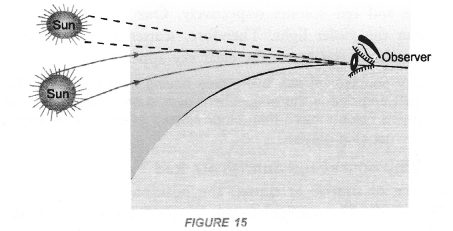
At noon, the sun is overhead. The rays of light from the sun enter the atmosphere normally and hence they do not bend at all while passing through the atmosphere. Therefore, the sun appears circular at noon.
Question 27.
Why is the colour of clear sky blue ? Explain. (CBSE 2012, 2014, 2015, 2016)
Or
Why does sky look blue on a clear day ? [CBSE (Delhi) 2008, 2011]
Answer:
When sunlight enters the earth’s atmosphere, the atoms or molecules of the gases present in the atmosphere scatter this light. Since wavelength of red colour is larger than the wavelengths of other colours in sunlight, so red colour is scattered least. Violet colour is scattered the most followed by blue, green, yellow, orange and red colours respectively. Our eye is more sensitive to the blue light than the violet light. Therefore, scattered light in the sky contains blue colour in plenty and hence the clear sky appears blue.
Note : Sky appears greyish over cities having industrial units. The smoke and dust particles in the atmosphere over such cities scatter red, orange and yellow colours more than other colours of small wavelengths. Hence, the sky appears greyish.
Question 28.
Why are stop signals on roads in red coloured light ?
[CBSE (Delhi) 2008, CBSE (All India) 2009, 2012, 2015]
Answer:
When light falls on the signal, all colours are scattered much more than that of red colour. So the red colour suffering least scattering remains confined around the signal, which in turn illuminates the signal significantly. Thus, the danger signals can be seen from very far off distances. Moreover, among all colours, red colour or red light is scattered least by smoke or fog. Hence, red signals are visible even through the smoke or fog.
Question 29.
What would have been the colour of sky if the earth had no atmosphere ? Give reason for your answer. (CBSE 2012)
Answer:
If the earth had no atmosphere, the colour of the sky would have been dark. The colour of sky depends on the scattering the sunlight due to the atmosphere. No atmosphere means no scattering of light.
Question 30.
State the difference in colours of the sun observed during sunrise/sunset and noon. Give explanation for each.
(CBSE 2013)
Answer:
The colour of the sun observed during sunrise/sunset is reddish, while its colour observed at noon is white. At sunrise/sunset, the sun is very far away from the observer. So, the sunlight travels longer distance through the atmosphere to reach the eyes of the observerer. The scattering of blue light is more than the scattering of red light. So, more red light reaches our eye and hence sun appears reddish.
During noon the sun is overhead and light from the sun travels less distance through air to reach our eye. In this case, scattering of all colours is very small. Hence, the sun appears white.
Long Answer Questions ( 5 Marks)
Question 1.
Write different parts of eye and explain their functions. Also explain, how an image of an object is formed on the retina of eye. (CBSE 2012)
Answer:
The main parts of an eye and their functions are given below :
- Cornea is the outermost part of the eye. It is transparent part of eye and allows the light to enter in the eye.
- Iris: It is a circular dark diaphragm having a hole in its centre. This hole is called pupil. The circular dark diaphragm has muscles and coloured pigments. The colour of an eye depends upon the colour of these pigments.
The function of iris is to control the size of the pupil. On the other hand, pupil controls and regulates the light entering the eye. The pupil becomes small when bright light falls on the eye. However, it becomes wide when there is dim light. - Lens: The eye lens is a crystalline double convex lens and made of transparent and flexible tissues. It is behind the pupil and held by the muscles called ciliary muscles. It focuses the images of objects on the retina of the eye.
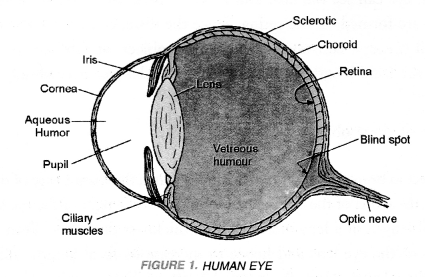
- Ciliary muscles: These muscles hold the eye lens in position. Ciliary muscles controls the focal length of the eye lens. When these muscles contracts, then the lens becomes thick and the focal length of the lens decreases. On the other hand, when ciliary muscles are relaxed, then the lens becomes thin and the focal length of the lens increases.
- Retina: It acts as a light-sensitive screen to obtain the image of the object. It contains number of cells in the form of rods and cones which are sensitive to light. These cells converts light energy into electrical impulses or signals.
- Optic nerve: Optic nerve is formed by the nerve fibres coming from the retina. It carries nerve or electrical impulses or signals to the brain. The brain finally interprets the signal.
Question 2.
What is short-sightedness ? List two causes for development of short-sightedness. Describe with a ray diagram, how this defect may be corrected using spectacles. (CBSE 2011, 2012)
Or
What is myopia ? State the two causes of myopia with a labelled ray diagram show
(i) the eye defect myopia,
(ii) correction of myopia using lens. [CBSE (All India) 2009, 2015]
Answer:
A human eye is myopic if it can see the near objects clearly but unable to see far off objects or distant objects clearly.
Correction of short sightedness or Myopia
The image of a distant object (i.e. at infinity) is formed in front of the retina of eye suffering from myopia as shown in figure 5(a). As the image of the object lying at infinity is not formed on the retina of the eye, so such object can not be seen clearly by the Myopic eye. The far point of such an eye is near to the eye as shown in figure 5(b).
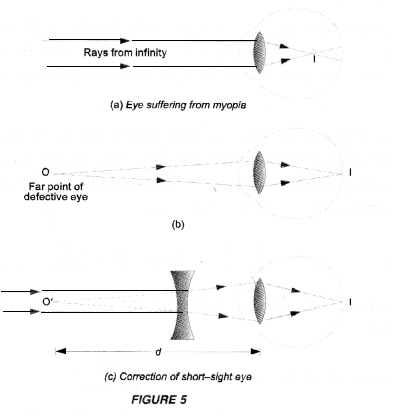
This defect can be corrected by using a concave lens of suitable focal length (or power). So, a man suffering from this defect wears spectacles having concave lens of suitable focal length. The concave lens used diverges the rays of light entering the eye from infinity. Hence this lens makes the rays of light appear to come from the far point (O’) of the defective eye as shown in figure 5(c).
Causes of Wlyopia: This defect arises due to either by
- the elongation of the eye ball or
- the excessive curvature of the cornea.
Question 3.
What is long-sightedness ? List two causes for development of long-sightedness. Describe with a ray diagram, how this defect may be corrected using spectacles. [CBSE (All India) 2005]
Or
What is hypermetropia ? State the two causes of hypermetropia. With the help of a ray diagram, show (i) the eye defect hypermetropia, (ii) correction of hypermetropia by using a lens. [CBSE (Delhi) 2009, 2015]
Answer:
A human eye which can see far off objects or distant objects clearly but can not see the near objects clearly is said to be suffered with a defect known as long sightedness or far sightedness or Hypermetropia.
Correction of long-sightedness (or Hypermetropia)
The image of a normal near point (which is 25 cm from the eye lens) is formed behind the retina of eye having long-sight defect as shown in figure 4(a). Hence, the image of the normal near point formed on the retina is blurred. The near point of such eye is little far from the near point of normal eye as shown in figure 4(b).
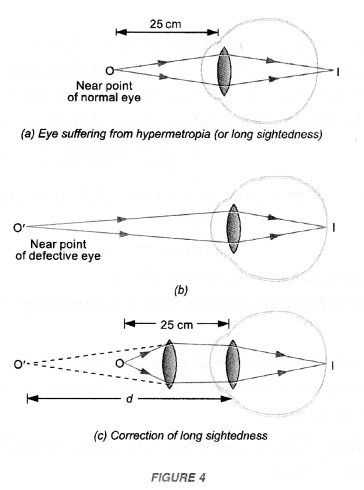
This defect can be corrected by using a convex lens of suitable focal length. So, a man suffering from this defect wears spectacles having convex lens of suitable focal length. The convex lens of spectacles reduces the divergence of rays of light entering the eye. Hence this lens makes the rays of light appear to come from the near point of the defective eye as shown in figure 4(c).
Causes of Hypermetropia: This defect arises due to either by
- the increase in the focal length of eye lens or
- the size of the eye ball becomes too small so that the light rays from the nearby points or objects are not brought to focus on the retina of the eye.
Question 4.
Describe with a neat diagram how near sightedness (Myopia) can be corrected by using appropriate lenses. [CBSE (Delhi) 2006]
Answer:
A human eye is myopic if it can see the near objects clearly but unable to see far off objects or distant objects clearly.
Correction of short sightedness or Myopia
The image of a distant object (i.e. at infinity) is formed in front of the retina of eye suffering from myopia as shown in figure 5(a). As the image of the object lying at infinity is not formed on the retina of the eye, so such object can not be seen clearly by the Myopic eye. The far point of such an eye is near to the eye as shown in figure 5(b).
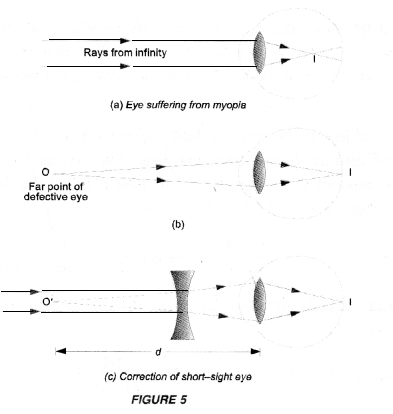
This defect can be corrected by using a concave lens of suitable focal length (or power). So, a man suffering from this defect wears spectacles having concave lens of suitable focal length. The concave lens used diverges the rays of light entering the eye from infinity. Hence this lens makes the rays of light appear to come from the far point (O’) of the defective eye as shown in figure 5(c).
Causes of Wlyopia: This defect arises due to either by
- the elongation of the eye ball or
- the excessive curvature of the cornea.
Question 5.
Explain refraction of light through a glass prism using a labelled ray diagram and hence define the angle of deviation.
Answer:
Refraction of Light Through a Prism
Prism is a homogeneous transparent refracting medium bounded by at least two non-parallel surfaces inclined at some angle.
A commonly used prism is shown in figure 6.
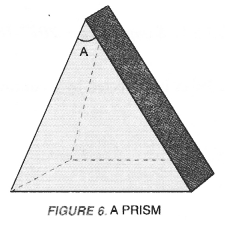
The two non-parallel plane surfaces participating in the refraction of light are called refracting surfaces. The angle between two non-parallel refracting surfaces is called angle of prism or refracting angle. It is denoted by A.
Find Angle of deviation of a ray of light passing through the prism Procedure
- Place a glass prism on a sheet of white paper.
- Mark its boundary with H.B. pencil.
- Now fix two pins at points B and C as shown in figure 7
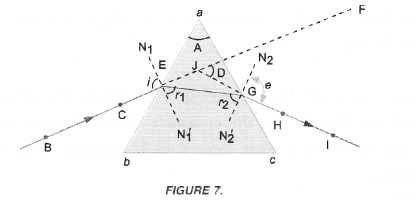
- Look through the refracting face ac and fix two pins at H and I such that the pins H and I and the images of pins B and C line in a straight line.
- Now remove the prism and all pins.
- Join the points B and C and extend this line so that it touches the refracting surface ab at point E.
- Also join the points H and I and extend this line so that it touches the refracting surface ac at point G.
- Also join points E and G.
- Draw perpendiculars N1N1‘ and N2N2‘ on the refracting surface ab at point E and on the refracting surface ac at point G
- ∠N1EC = ∠i, angle of incident and the ray BCE is the incident ray.
- ∠N2GH = ∠e, angle of emergence and the ray GHI is the emergent ray.
- Produce the emergent ray GHI backward so that it intersects the incident ray produced forward at point J.
- ∠FJG = ∠D, angle of deviation of the incident ray of light passing through the prism.
Thus, angle of deviation of a ray of light is defined as the angle between the directions of incident ray of light and the emergent ray of light.
Hope given Previous Year Question Papers for CBSE Class 10 Science Chapter 11 Human Eye and Colourful World are helpful to complete your science homework.
If you have any doubts, please comment below. Learn Insta try to provide online science tutoring for you.